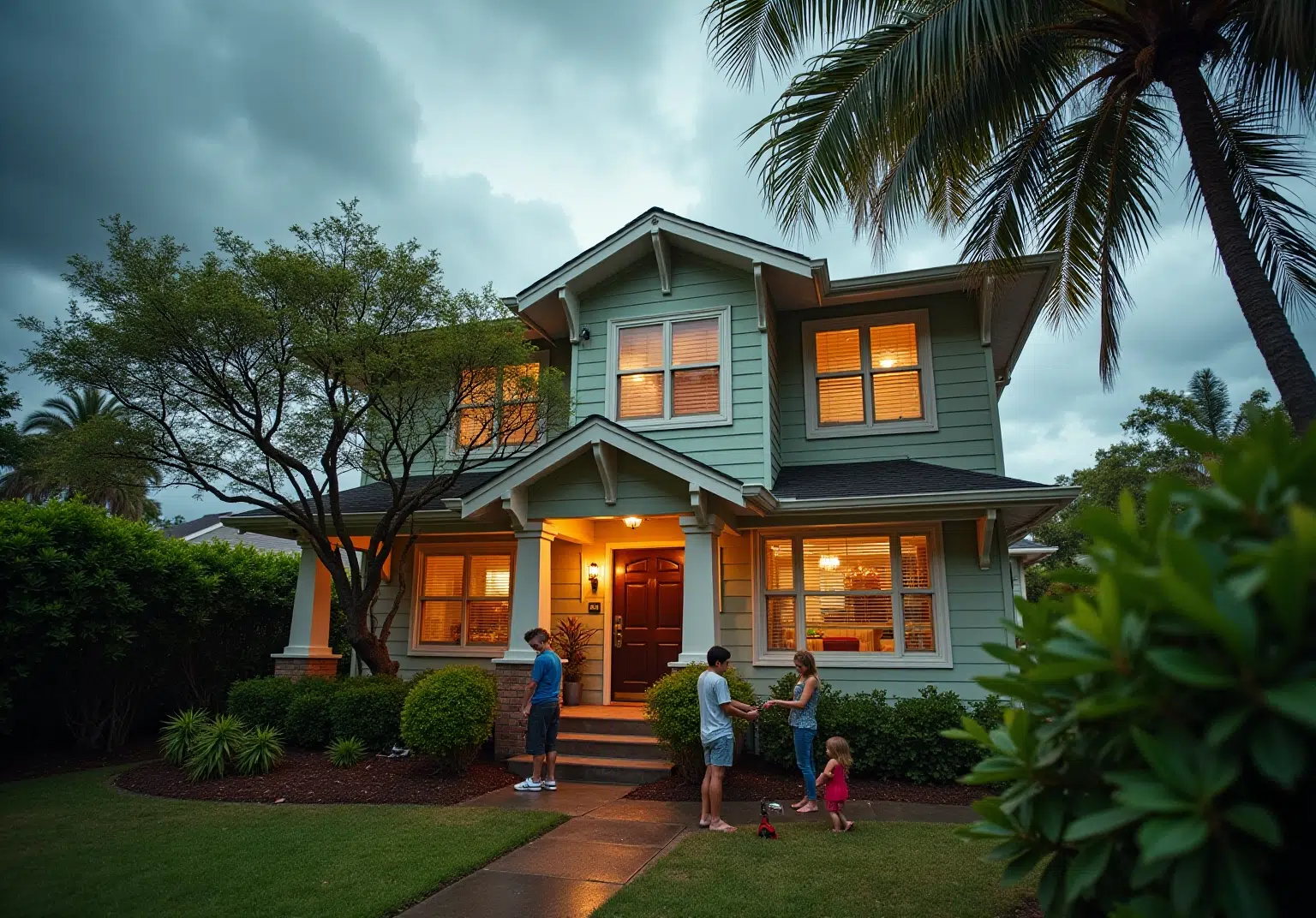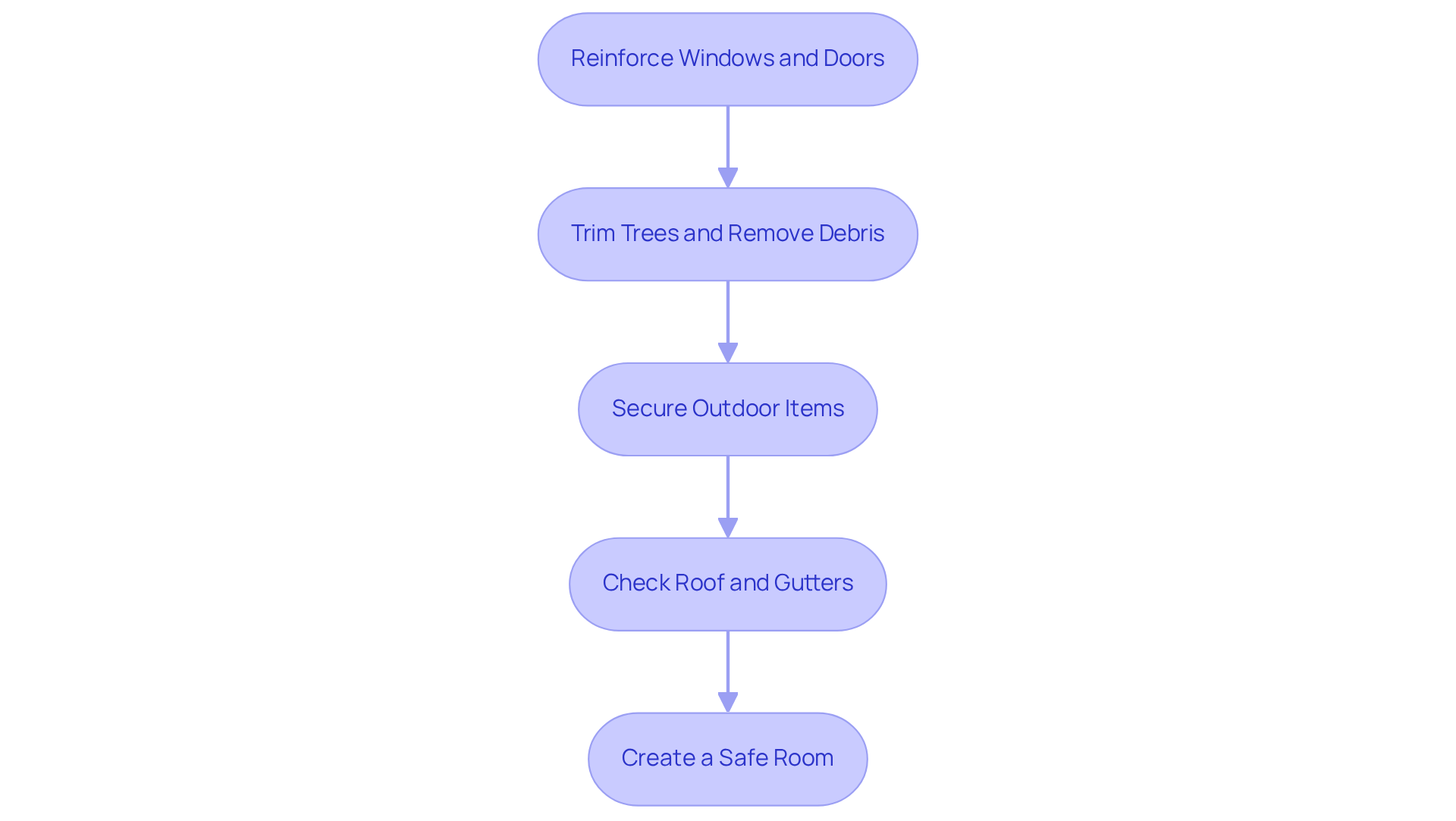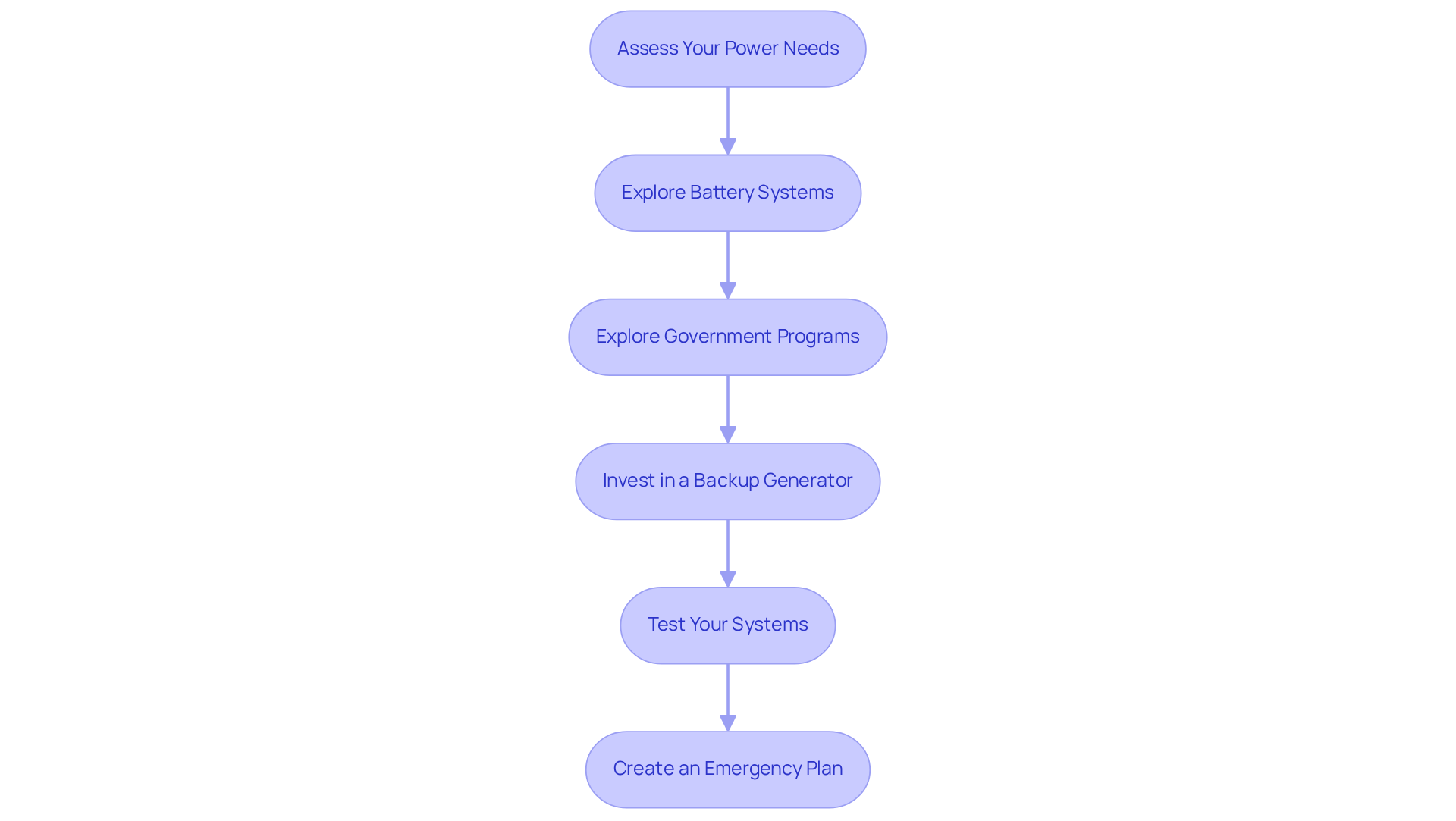Overview
As homeowners in Honolulu, you may be feeling concerned about the potential impact of storms on your property. It’s common to worry about how to best prepare for severe weather events. To enhance your safety and readiness, it’s essential to:
- Assess local weather risks
- Secure your property
- Consider implementing backup power solutions
Start by researching historical weather patterns to understand the challenges you might face. Reinforcing windows and doors can provide peace of mind, ensuring that your home is better protected against strong winds and heavy rain. Additionally, assessing your power needs is crucial; having backup power solutions can keep your household running smoothly during outages. Together, we can work towards ensuring your home is a safe haven, ready to withstand whatever nature may bring.
Introduction
Preparing for storms in Honolulu is not merely a precaution; it’s an essential responsibility that every homeowner in this beautiful tropical paradise must embrace. We understand that with the region’s unique weather patterns and potential hazards, the thought of safeguarding your home can feel overwhelming. However, knowing how to effectively protect your property can truly make a difference during severe weather events.
What steps can you take to ensure your safety and shield your home from the unpredictable forces of nature? This guide delves into critical strategies for:
- Assessing storm risks
- Securing your home
- Implementing backup power solutions
Empowering you to navigate the challenges posed by storms with confidence and peace of mind.
Assess Storm Risks Specific to Honolulu
- Research Local Weather Patterns: It’s important to familiarize yourself with the historical weather data for Honolulu, particularly concerning the frequency and intensity of storm Honolulu events. The National Weather Service provides valuable insights, including an average event probability score of 8.17%. This information can be instrumental for homeowners in anticipating potential impacts from the storm in Honolulu.
- Identify Vulnerable Areas: Take a moment to assess your property for vulnerabilities. Are there low-lying areas that might be prone to flooding, or structures that may struggle against high winds? Local hazard maps from the Hawai’i Emergency Management Agency can be incredibly helpful in this evaluation, allowing you to understand your unique risks better.
- Assess Your Home’s Risk: Consider whether your residence is situated in a flood zone or near coastal regions that might experience surge events. Understanding these risks is essential for . As noted by meteorologists, this knowledge is critical for safeguarding your home and loved ones.
- Stay Informed: We understand how important it is to stay updated. Signing up for local alerts and warnings will ensure you receive timely updates about approaching severe weather. This proactive approach enables you to stay ahead of potential threats and take necessary actions promptly. By remaining informed, you can prepare your residence and family for any severe weather occurrences.
By taking these thoughtful steps, together we can effectively evaluate weather hazards specific to storm Honolulu and enhance your readiness for future climatic events.
Secure Your Home and Property
- Reinforce Windows and Doors: We understand that safeguarding your home is a priority, especially during a storm in Honolulu. Installing protective shutters or using plywood to cover windows is essential for protecting your residence from high winds and flying debris. Ensure all doors are secured with deadbolts, and consider adding braces to sliding doors for added stability, giving you peace of mind.
- Trim trees and : It’s common to feel anxious about potential projectiles during a storm in Honolulu. Regularly trimming trees and removing loose branches can significantly lessen this risk. Clear any debris from your yard that might be blown around, as this simple step can help prevent harm to your home and nearby properties. Remember, regular maintenance of trees is crucial, as it reduces the chances of damage during a storm in Honolulu.
- Secure Outdoor Items: We know how important it is to protect your belongings. Bring in or secure outdoor furniture, decorations, and any other items that could be lifted by strong winds. For larger items, use weights or tie-downs to keep them anchored, minimizing the risk of them becoming dangerous projectiles.
- Check Roof and Gutters: Inspecting your roof for loose shingles and repairing any damage promptly is a proactive way to safeguard your home. Cleaning gutters and downspouts is crucial to ensure proper drainage and prevent water accumulation, which can lead to flooding during heavy rains. Taking these steps can help you feel more secure.
- Create a Safe Room: Designating a safe room in your home where family members can gather during a storm in Honolulu is a wise choice. This room should be located away from windows and equipped with emergency supplies, ensuring safety during severe weather events. Additionally, prepare an emergency kit stocked with non-perishable food, water, medications, and important documents to ensure your family is ready for any situation. Together, we can make sure you are well-prepared.
Implement Backup Power Solutions
- Assess Your Power Needs: We understand that during an outage, it’s crucial to identify the essential appliances and systems that require power. Think about your refrigerators, medical devices, and communication tools—these are vital for your comfort and safety.
- Explore Battery Systems: It’s worth examining battery storage alternatives that can provide energy during outages. Systems like the Tesla Powerwall are designed to store energy produced from photovoltaic panels, ensuring you have access to electricity even when the grid is down. As of 2023, Hawaii’s battery storage capacity stands at 0.36 GW, reflecting a growing trend towards integrating renewable energy with battery solutions for enhanced reliability.
- Explore Government Programs: You might want to investigate available that can assist Long Beach tenants in obtaining energy solutions. These programs may offer financial incentives or resources to help you switch to renewable energy, making it more affordable and accessible.
- Invest in a Backup Generator: Consider determining the necessity of a backup generator based on your power requirements and budget. You have options, including portable generators for smaller needs or whole-house generators for comprehensive coverage. Remember, correct installation and upkeep are essential to guarantee reliability during severe weather.
- Test Your Systems: It’s important to regularly test your backup power systems to ensure they are operational. This includes running your generator and checking the battery levels in your solar systems to confirm they are ready for use when needed.
- Create an Emergency Plan: Developing a clear plan for utilizing your backup power systems during a storm in Honolulu is vital. Include detailed instructions for your family members on operating generators and managing battery systems, ensuring everyone knows how to respond effectively in an emergency. Together, we can ensure that you and your loved ones are prepared and safe.
Conclusion
Preparing for storms in Honolulu is a critical responsibility for homeowners, ensuring safety and minimizing damage during severe weather events. We understand that the unpredictability of storms can be concerning, but by understanding local storm risks and implementing proactive measures, you can significantly enhance your readiness for potential storms. This guide emphasizes the importance of assessing storm vulnerabilities, securing your home, and establishing reliable backup power solutions.
Key strategies discussed include:
- Evaluating specific storm risks in Honolulu
- Reinforcing home structures
- Creating a safe space for your family during emergencies
Additionally, we highlight the value of backup power systems and the necessity of regular maintenance to ensure they function effectively when needed most. By following these essential steps, you can protect your property and loved ones from the unpredictable nature of storms.
Ultimately, storm preparedness is not just about reacting to immediate threats but fostering a culture of proactive safety and resilience. We encourage you to take these insights to heart, implement the suggested measures, and remain vigilant in your preparations. Together, we can contribute to a safer community, ready to face whatever weather challenges may arise in the future.





